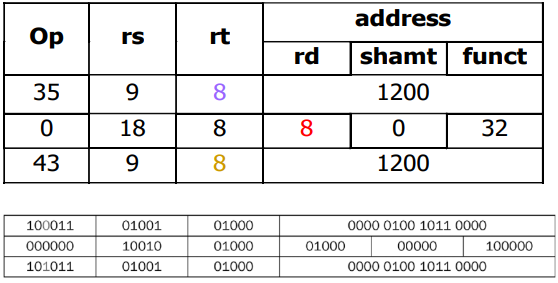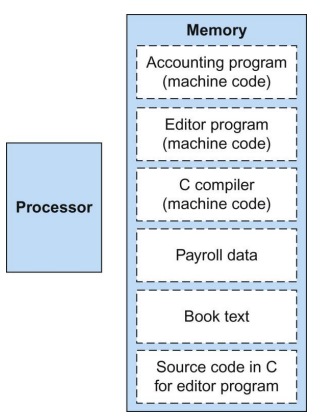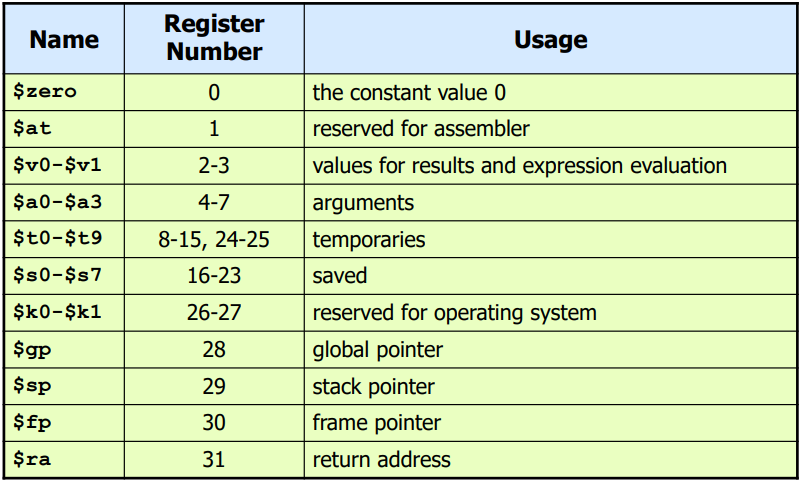0x01. 컴퓨터에서 명령어의 표현
1.1 명령어 형식(Instruction format)
- 명령어의 레이아웃
- 하나의 명령어가 바이너리 필드들로 구성된 형식
(1) R-type 명령어 형식(Register-type)

-
op : 명령어의 기본적인 연산자 (opcode)
-
rs, rt : 1번째, 2번째 송신지 피연산자 레지스터 (source operand)
-
rd : 목적지 피연산자 레지스터 (destination operand)
- 연산의 결과값을 받음
-
shamt : 쉬프트의 양 (몇 번 shift했는지, shift amount)
-
funct : op필드(연산자)에서 나타난 연산의 특정한 연산 종류를 지정 (function code)
- ex) opcode extension
- R-type의 opcode bits는 모두 000000인데, 이 funct로 add, sub 이런것들을 구분한다.
Example: 어셈블리어를 → 기계어로 번역해봐라.
add $t0, $s1, $s2 = add $8, $17, $18- [Answer]

- 1번째 필드와 마지막 필드 : 덧셈 연산
- 2번째 필드 : 처음 송신 피연산자의 Register number ($s1=$17)
- 3번째 필드 : 다음 송신 피연산자의 Register number ($s2=$18)
- 4번째 필드 : 목적지 피연산자의 Register number ($t0=$8)
- 5번째 필드 : 명령어에 사용되지 않았음 (0으로 설정)
(2) I-type 명령어 형식(Immediate-type)
- 설계 원칙 3 : 좋은 설계를 위해서는 적당한 타협이 필요하다.

| Instruction | Format | op | rs | rt | rd | shamt | funct | 상수or주소 |
|---|---|---|---|---|---|---|---|---|
| add | R-type | 0 | reg | reg | reg | 0 | 32 | X |
| sub | R-type | 0 | reg | reg | reg | 0 | 34 | X |
| add immediate | I-type | 8 | reg | reg | X | X | X | 상수 |
| lw (load word) | I-type | 35 | reg | reg | X | X | X | 주소 |
| sw (store word) | I-type | 43 | reg | reg | X | X | X | 주소 |
Example: A[300] = h + A[300] ;
lw $t0,1200($t1) # Temporary reg. $t0 gets A[300]
add $t0,$s2,$t0 # Temporary reg. $t0 gets h+A[300]
sw $t0,1200($t1) # Stores h+A[300] back into A[300]- [Answer]

1.2 기계어 예시

1.3 전체적인 그림

- 명령어는 결국 숫자로 표현된다.
- 프로그램도 읽히거나 쓰기위해 그냥 메모리에 숫자로 저장된다.
0x02. 논리 연산자(Logical Operations)
| 논리 연산자 | C 연산자 | Java 연산자 | MIPS 명령어 |
|---|---|---|---|
| Shift left | << | << | sll |
| Shift right | >> | >>> | srl |
| Bit-by-bit AND | & | & | and, andi |
| Bit-by-bit OR | | | | | or, ori |
| Bit-by-bit NOT | ~ | ~ | nor |
2.1 MIPS Shift 연산
(1) 개념
- 논리 쉬프트(Logical shift) :
- 오른쪽 논리 쉬프트(Logical shift right) = 0
- 왼쪽 논리 쉬프트(Logical shift left) = 0
- 산술 쉬프트(for 2's complement) :
- 오른쪽 산술 쉬프트(Arithmetic shift right) = (cf) ÷2
- 왼쪽 산술 쉬프트(Arithmetic shift left) = 0 (cf) *2
- 순환 쉬프트(=rotate) :
- 오른쪽 순환 쉬프트(Circular shift right) =
- 오른쪽 순환 쉬프트(Circular shift left) =
(2) MIPS 쉬프트 명령어
- sll(shift left logical) ; funct = 000 000 # 0
- srl(shift right logical) ; funct = 000 010 # 2
- sra(shift right arithmetic) ; funct = 000 011 # 3
명령어 형식

-
sllv(shift left logical variable)
-
srlv(shift right logical variable)
-
srav(shift right arithmetic variable)
- ex) sllv $t2, $s0, $s1
-
rotr (rotate word right) ; funct = 000 010 (SRL)
-
rotrv (rotate word right variable) ; funct = 000 110 (SRLV)
2.2 MIPS Logical 연산
- and $t0,$t1,$t2
- or $t0,$t1,$t2
- xor $t0,$t1,$t2
- nor $t0,$t1,$t2 (cf) nor $t0,$t1,$zero
- andi $s1,$s1,100
- ori $s1,$s1,100
- xori $s1,$s1,100
- lui $s1,100
0x03. 의사결정을 위한 명령어
3.1 조건문 분기
(1) 명령어 예제(같은지 비교,equal)
-
if~go to와 비슷하다. -
beq register1, register2, L1 -
bne register1, register2, L1- 참고로 L1은 레이블의 주소값(상수)이다.(Else: 나 Exit: 처럼)
-
ex)
if (i==j) f=g+h; else f=g-h;
bne $s3,$s4,Else # go to {Else} if i≠j
add $s0,$s1,$s2 # f=g+h (skipped if i≠j)
j Exit # unconditional branch
Else: sub $s0,$s1,$s2 # f=g-h (skipped if i=j)
Exit:(2) 명령어 예제(작은지 비교, set on less than)
slt $t0,$s3,$s4 # if($s3<$s4) then $t0=1
# else $t0=0
================================================================
slti $t0,$s2,10 # if $s2<10 $t0=1; else $t0=0참고 : 의사코드
blt $s0, $s1, Less: branch on less than하지만 MIPS architecture에서는 blt 명령어를 쓰지 않는다. 그 이유는 모든 비교가 slt, slti, beq, bne 그리고 $zero의 조합으로 가능한데, clock cycle time이 증가하기 때문 혹은 cpi가 늘기 때문에 굳이 blt라는 명령어를 쓰지않는다. 이걸 만들바에 차라리 slt같은것 하나 더 쓰는게 더 이득이다.
3.2 반복문
(1) 예제
- ex)
while (save[i]==k) i += 1;- 단, save의 base address가 $s6라고 가정한다.
- i, k는 각각 $s3, $s5라고 가정한다.
Loop: sll $t1,$s3,2 # 임시레지스터$t1 = 4*i
add $t1,$t1,$s6 # $t1 = save[i]의 주소
lw $t0,0($t1) # Temp reg $t0 = save[i]
bne $t0,$s5,Exit # go to Exit if save[i]≠k
addi $s3,$s3,1 # i = i + 1
j Loop # go to Loop
Exit:3.3 Jump
(1) 예제
- j (jump) : Lable의 주소값(상수값)으로 이동할 때 j를 쓴다.
j Loop- jr (jump register) : Lable의 주소값이 레지스터에 들어있을 때 jr을 쓴다. 함수호출(function call)을 끝내기 위한 명령어이다.
jr $t0 # register($t0)내에있는 주소로 jump!
# i.e. PC ← $t0
jr $ra # 프로시저로부터 리턴, 보통 이 형식으로 사용한다.PC는 Program Counter의 약자로 레지스터 $0~$31에 포함되지 않는 특수 레지스터이다. 이 레지스터는 현재 수행해야 하는 명령어의 주소값이 들어있다.
- jal (jump and link) :명령어는 1개이나 2가지 action이 일어난다. 리턴어드레스 레지스터에 PC+4 를 저장하고 PC에는 함수주소를 넣는다. 즉 함수호출(function call)을 시작하기위한 명령어이다.
jal ProcedureAddress # $ra ← PC + 4, (단 $ra는 return address )
# PC ← Procedure address0x04. MIPS 레지스터 정리

참고 : $sp는 ESP이고, $fp는 EBP이다.
- $v0-$v1 은 함수의 리턴값이 저장된다.


